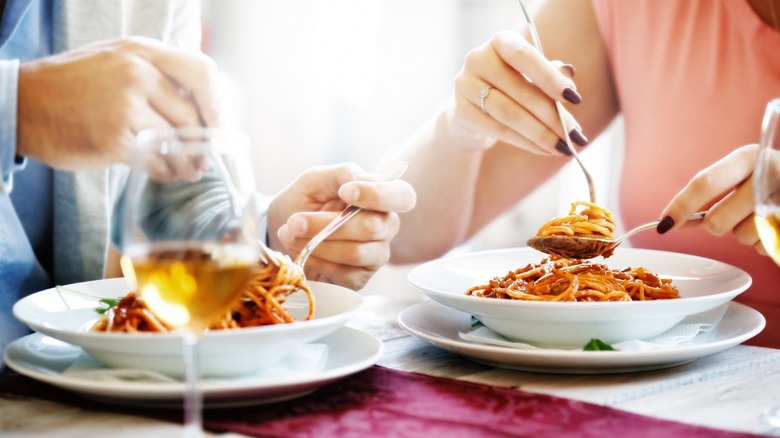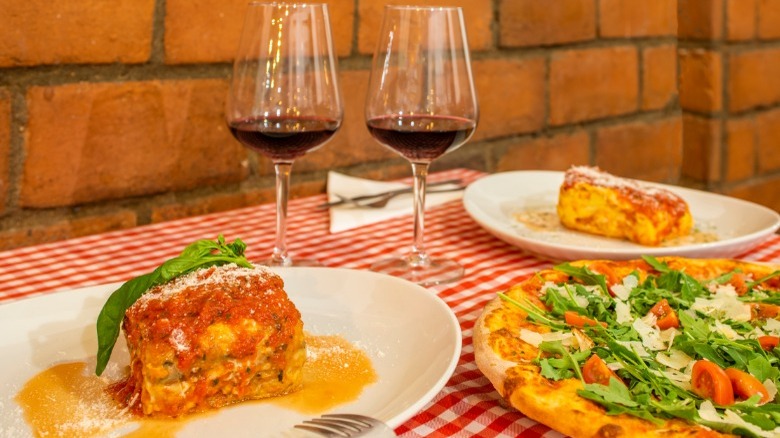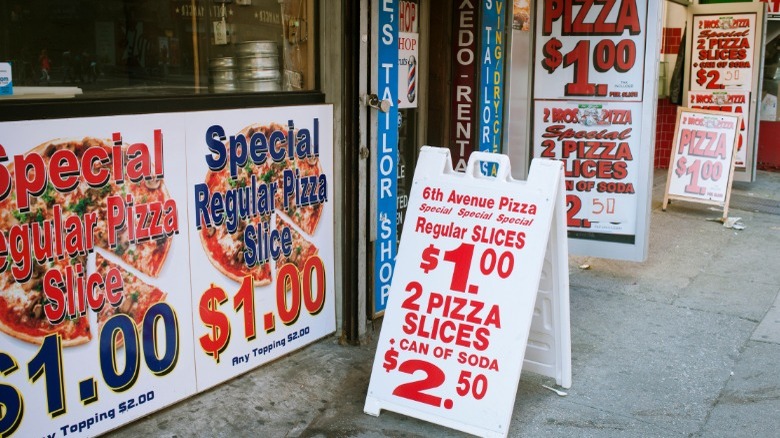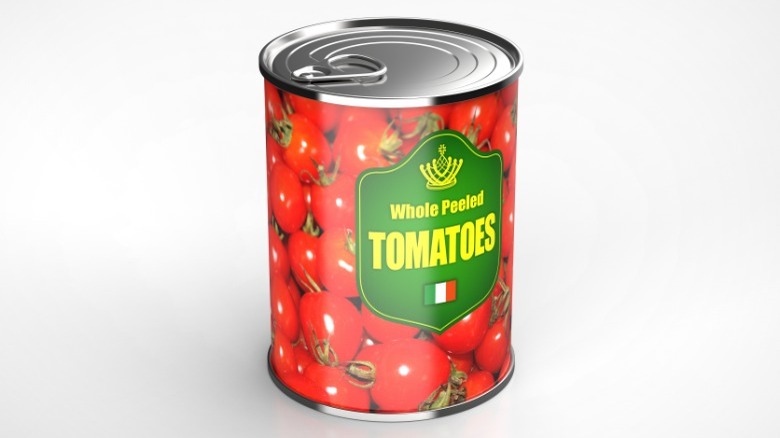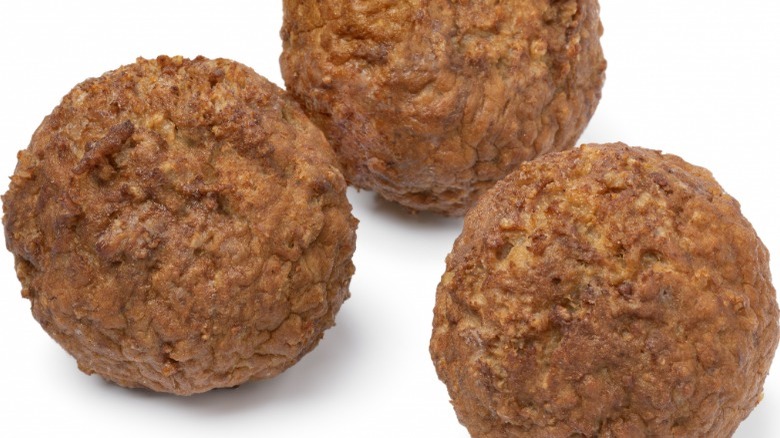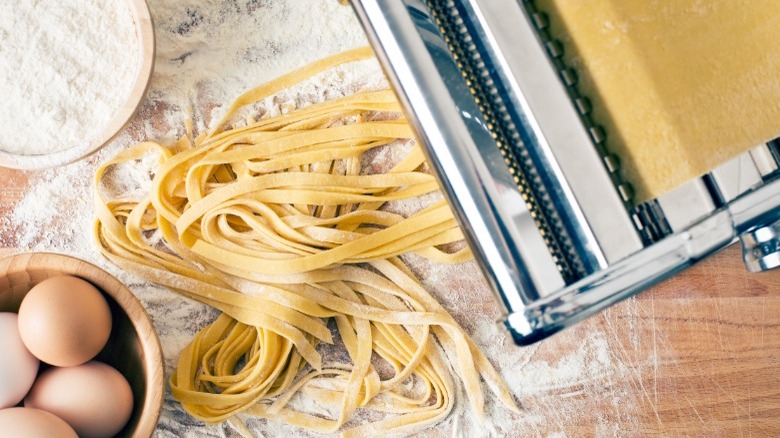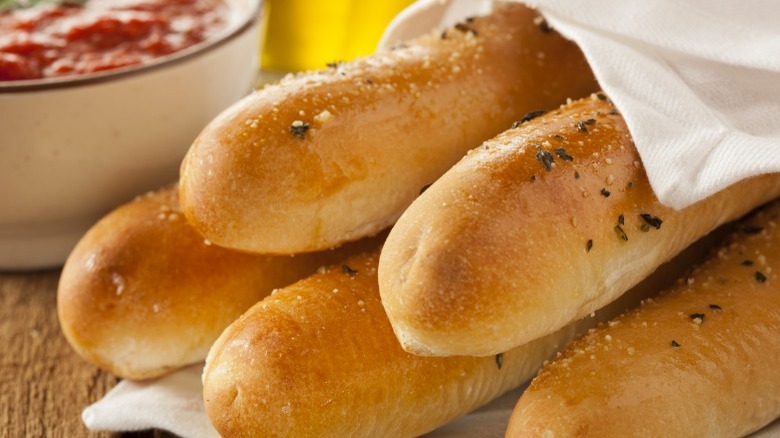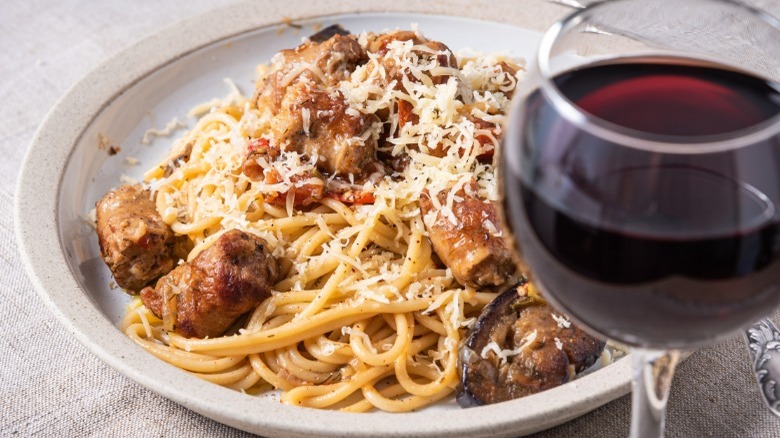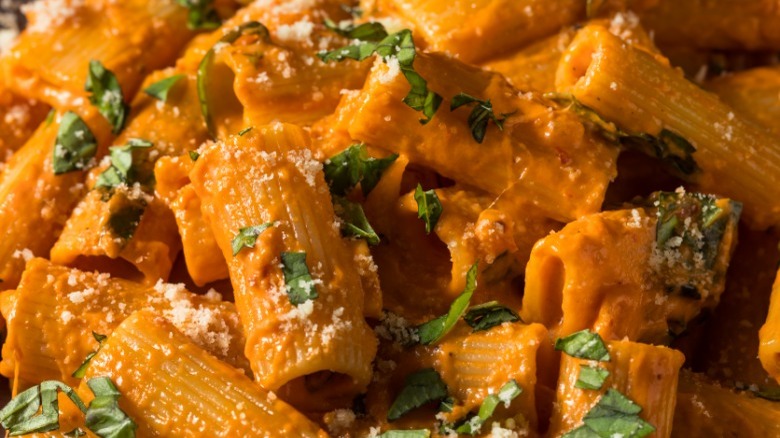12 Red Flags To Look Out For At Italian Restaurants
Cooking spaghetti and meatballs at home isn't hard at all, but isn't it nice to have a chef prepare it for you at a real Italian restaurant? This beloved dish is also found at diners and other American-themed restaurants, but Italian eateries are the go-to choice for practiced fans of the dish. We also recommend sticking to Italian restaurants for Italian food to ensure the best results.
Not every Italian restaurant offers high-quality food or service, though. And no one likes to look forward to a delicious meal and then be disappointed. Have you ever arrived at a new spot and noticed certain things that made you question your decision to eat there? Some red flags are apparent right away, while others are not; this can also happen in old favorite restaurants that have jumped the shark. The worst Italian restaurants will fail in all respects, like atmosphere, food, and service, while others will just be meh.
But the prices of dining out are at an all-time high, so why should you settle for a bored server, flavorless marinara, or questionable cheese at an Italian restaurant? This is one of the most popular cuisines in the world, and you probably have several nearby restaurants to choose from. So when you see that your regular spot is showing signs of wear or realize that a new one has any red flags, you'll probably want to take your business and appetite elsewhere.
1. Tacky decor
You have likely seen countless red-and-white checkered tablecloths in Italian-American restaurants, and that's not necessarily a bad thing. But when they're made out of plastic (or covered with plastic), that could be a red flag. Look at your table and around the dining area: Are there faded, framed pictures of Italy? Fake, dusty flower centerpieces? You might want to head for the door. Not only do these things look tacky, but owners that don't invest in nice decor probably neglect the food, too.
Elk Grove News.Net agrees that red-and-white checkered tablecloths can be an indicator of good Italian food, especially when you're looking for a hearty plate of lasagna or veal parm. So don't let the initial sight deter you, but check to see if they're made from linen.
Many Italian-American restaurants use these tablecloths in their decor, along with carafes of olive oil on the tables. ResearchGate points out that these are symbolic elements that create associations with Italy. We appreciate the efforts as long as the effects are homey and authentic, and not tacky.
2. Menu issues
Would you order Chinese food if you saw it on a Mexican restaurant menu? This example is exaggerated, but you get the point. Imagine looking at an Italian restaurant menu and seeing steak frites as an entrées. Okay, it's fine to have a burger and fries or mac and cheese on the kids' menu but there darn well better be spaghetti and meatballs too.
According to mi'talia Kitchen & Bar, you won't see other cuisines on menus at the best Italian restaurants. And if you're in Italy, many of the menus will only be in Italian: English translations on the menu are a sure sign of a touristy restaurant. Photos of the food on the menu are another red flag.
Travel Food and Booze claims that those pics are designed to show tourists (who don't have a clue) what the food looks like. True Italians don't need that extra information. Much of the time, the food will look different than pictured.
And if you're being really picky about authenticity, you won't want to eat at Italian restaurants with menus that are heavy on Italian-American food. Believe it or not, heavy dishes like chicken parmesan were not created in the Old Country. Devour explains that fettuccine Alfredo is only found in two restaurants in Rome, even though it's popular in the U.S. and other countries.
3. The place is like a graveyard
A good Italian restaurant will have most of its tables filled during weekday lunch and dinner hours and have lines or require reservations on the weekends. And when the food is served in large portions and/or family style, you can expect plenty of noise and camaraderie. When you're the only table or there are one or two others, you might feel awkward and realize that business might not be good at the restaurant.
According to US Foods, that staff shortages are another red flag of a restaurant that is having problems. If you have to wait too long to have your wine uncorked or your mussels in white sauce presented, there may only be one server and one chef. Once this happens, rest assured the food quality will not be that great, either.
Washington City Paper points out that many restaurants also face hard times because of rent increases and oversaturation (too many similar restaurants within a close area). So it's not always the food quality that's the problem. Some try to survive by offering patron discounts like two-for-one pizzas and free appetizers with entrees. This doesn't mean that all special offers are red flags, though.
A fine Italian restaurant might offer lunchtime or weeknight discounts, but you won't see major deals on weekends. Consistently empty tables and poor service are red flag flags that an Italian restaurant will soon be shuttering its doors for good.
4. The servers don't understand Italian food
A sure sign of an authentic Italian restaurant is staff members who speak Italian or have Italian accents. This is a great touch but not necessary; an understanding and passion for the food and ingredients are most important. Have you ever asked a server a question about a nightly special, only to have them look confused and tell you that they'll be right back?
Curious Appetite posts that Italians are passionate about their food, so the chefs should be able to share those feelings with their waitstaff. Good Italian servers are familiar with new and older menu items, are thoroughly briefed on the daily specials, and share their enthusiasm about the food. They should be willing and able to answer specific questions about the food ("Does that marsala sauce have cream in it?") and not become frustrated when a diner has a complaint.
Are they perfect? Of course not, and once in a while, a server might get an order wrong or drop a plate of pasta. Expect the pace in upscale, authentic Italian restaurants to be more leisurely, and don't be surprised if a server doesn't bring your bill until you ask. That is the way that things are done in Italy.
5. It doesn't smell right
One of the worst red flags in an Italian restaurant is a bad stink: Talk about losing your appetite! When you walk into a great Italian restaurant, the aroma should be pleasing, not offensive. Red flags like burnt pizza, cleaning chemicals, and rancid food are clear indicators that something might be amiss.
But where do those offensive odors come from? The Restaurant Life explains that newer restaurants might smell like cleaning products since they are still getting used to new routines and may end up using different supplies later. Older ones are set in their ways and are more efficient.
Chronic bad smells can develop when restaurants aren't cleaned often enough. But if it's an isolated incident like burned food, attentive staff members will remedy the situation, and things will smell better soon enough.
Hardcore Italians Blog claims that some of the best Italian cooking smells are garlic, fried meatballs, homemade soup, onions, and basil. These are the kinds of things that you should be smelling. And if the restaurant has its own bakery (lucky you!) you'll also be taking in aromas of pizzelles and other goodies. You should notice some of these when you walk in, especially if the kitchen is near the entrance. Your food should smell pretty amazing, too.
6. They serve the wrong kind of pizza
It's fine for Italian restaurants to have pizza on their menus if that's what you are craving: Some Italian restaurants specialize in it, while others don't. Pizza Bien explains that authentic Italian pizza is thinner than American pizza and is not covered in as much cheese. It also tends to be less dry and less greasy.
Thrillist shows that some classically-trained Italian chefs have unpleasant things to say about Americanized pizza: Simone Falco owns Rossopomodoro and SIMO pizza restaurants and claims that some pizzerias cut corners by adding sugar and using unripe tomatoes. He lets his dough rise for as long as 36 hours before it's baked. When the yeast in the dough isn't given enough time to ferment, the yeast expands in your stomach. That and too much salt can leave you feeling very thirsty after you're finished eating, which is a red flag for inferior pizza.
So if an Italian restaurant is selling dollar slices, you will be getting what you pay for. Major pizza chain restaurants like Pizza Hut are not considered to be authentic Italian restaurants, of course. But if you want traditional Italian pizza, avoid those and the buck-a-pop shops. A fine Italian eatery will have ungreasy, gourmet, and appropriately-priced pizzas.
7. No seasonal ingredients
Here's a big red flag: Any Italian restaurant that's had the same menu for decades should be ashamed of itself. This cuisine is all about using fresh, seasonal ingredients, so if the menu is the same year-round or older than your grandma, walk away. You can taste the difference when Italian chefs use a lot of canned and frozen ingredients.
DeNicola's claims that plump tomatoes and tender zucchini are two signs of real Italian food, and we couldn't agree more; peak ripeness equals better taste. Fresher is better, and not only because of the flavor.
According to Seasonal Food Guide, seasonal produce is prepared not long after it is harvested, and this supports local farmers and local economies. Seasonal foods are also more nutritious than out-of-season and packaged or processed products.
Nourish by WebMD adds that seasonal foods not grown in bulk are more nutritious. That's because growers often add modifications (like additives) that can affect taste and nutrition benefits. Vegetables and fruits that are allowed to grow naturally thrive on their own. And since they taste better, you'll want to eat more! This red flag might be harder to see, so if you're not sure if an Italian restaurant is using fresh, seasonal ingredients, ask.
8. Oversized meatballs
Tennis-sized meatballs can be tempting, but they are totally unauthentic. Border Food Machinery explains that real Italians make smaller ones, and we see no reason to mess with perfection. Think about it: Is that giant round thing sitting on your pasta 100 percent beef? Nope, it's probably all fluffy and loaded up with fillers like cheese and breadcrumbs. So if an entrée contains three or fewer oversized meatballs, you will likely be eating less meat and more of other ingredients.
But wait: Is spaghetti and meatballs an authentic Italian dish? Smithsonian Magazine claims that it is not found in Italy. Italian meatballs are known as polpettes and aren't larger than golf balls. They're made with any kind of meat (even fish) and are eaten plain or in soups.
But after Italian immigrants started arriving in the U.S. in the late 1800s, they started consuming more meat and pairing it with red sauce and pasta. Italian Villa Restaurant agrees that Italian immigrants invented the dish, but since they were living in the U.S. at the time, spaghetti and meatballs is definitely an Italian-American dish. We won't go so far as to red-flag the dish, but you should definitely avoid oversized meat monsters.
9. No homemade pasta
You can buy a box or bag of dried penne at any grocery store, so why order the same kind of thing at an Italian restaurant? Homemade pasta can be fresh or dried but is always made with healthier ingredients. According to Cuisine at Home, homemade pasta has a better taste and texture, as well as no additives. Dried pasta is farmer, and it pairs better with thicker, saucier dishes like lasagne. You'll notice that fresh homemade pasta is used more often in oil- and cream-based dishes.
Uno Casa explains that homemade pasta is made from flour, egg, and pasta. If it's dried, it contains no eggs, and semolina flour is used. Fresh homemade pasta is lighter and only lasts for two to three days; it can be frozen, though. You'll pay more for homemade pasta at Italian restaurants, but boy, is it worth it. Most of the time, the menu will show that it's homemade, or your server will (enthusiastically) tell you. What could be better than homemade fresh ravioli stuffed with cheese and other fresh ingredients? Mangia!
10. Fluffy breadsticks
Italian-American restaurants often have overfilled bread baskets on the tables, whether you ask for them or not. Olive Garden, in particular, is known for its never-ending breadsticks: These are anything but stick-like. They are served hot right out of the oven, and no one can deny their deliciousness.
But you won't see these in truly authentic Italian restaurants; those tend to have grissini instead. According to Border Food Machinery, these slim sticks break when you bite into them because they aren't fluffy or doughy. They're much lighter than breadsticks and won't fill you up. This makes a lot of sense when you want to have enough room to enjoy your appetizers, entrees, and desserts.
If you really want to eat like an Italian, you won't have any bread before dinner. MP Tours posts that other kinds of bread and rolls are usually eaten during the meal, not beforehand. If bread is listed as an appetizer on the menu, that's an exception. Italians also don't dip their bread in olive oil. Or butter. So go ahead and enjoy Olive Garden's breadsticks with butter, but don't look for them (or ask for them, heaven forbid) when you're at an authentic Italian restaurant.
11. Powdered cheese
We have nothing against sprinkling parmesan cheese on pizza or Italian entrees, as long as it isn't the fake powdered stuff. According to EWG (Environmental Working Group), Kraft 100 Percent Grated Parmesan Cheese has real cheese, but it also contains cellulose powder and potassium sorbate. But if you see a container of powdered parmesan on the table at an Italian restaurant, who knows if it's real? For all you know, it could be a fake product that's mostly made of oil.
Freshly grated is so much better, and it's a real treat when servers do this tableside. Cucina by Elena makes a strong case for this, pointing out the most obvious thing first: It's fresher. Besides that, it's less likely to clump up in recipes and on top of food. It also melts better, so if you have a hot dish...mmmm.
Foodbeast claims that Parmigiano-Reggiano and Parmesan cheese are two different types of cheese, so if you want to get super-picky about your parmesan, ask if the cheese is Parmigiano Reggiano D.O.P.
Champagne and Parmigiano Reggiano are both controlled-origin products, so the names cannot be used on other goods (to be called Champagne, the sparkling liquid must be made in Champagne, France, via VinePair). Real Parmigiano-Reggiano is labeled as D.O.P. (Protected Designation of Origin). Things labeled as Parmesan cheese are not regulated, so you never know what you might get.
12. The sauce isn't mixed into the pasta
Have you ever ordered a pasta dish in an Italian restaurant only to find out that the sauce was ladled on top without care? Yep, that's a red flag. According to Why Italians, this is a familiar way of serving pasta in Italian-American restaurants, but it's never done this way in Italy.
When freshly drained, hot pasta is added to a sauce, starch is released from the pasta. This binds the sauce to the pasta so that neither is overwhelmed by the other. Chefs in Italian restaurants who ladle globs of sauce on top of pasta just aren't getting it. Why should you have to be the one to mix it in?
DeLallo confirms that Italian sauces should always be combined with pasta before it is served and explains how easy it is to do at home. When the sauce is cooked and simmering, add in hot, cooked pasta and mix gently for one to two minutes. You can add a bit of the leftover pasta cooking water to thin it out if necessary.
And when you have it prepared this way in an Italian restaurant, you will never see a pool of extra sauce in the bottom of your bowl or plate. This is a good thing because you won't have any of those fluffy breadsticks to mop it up with.
